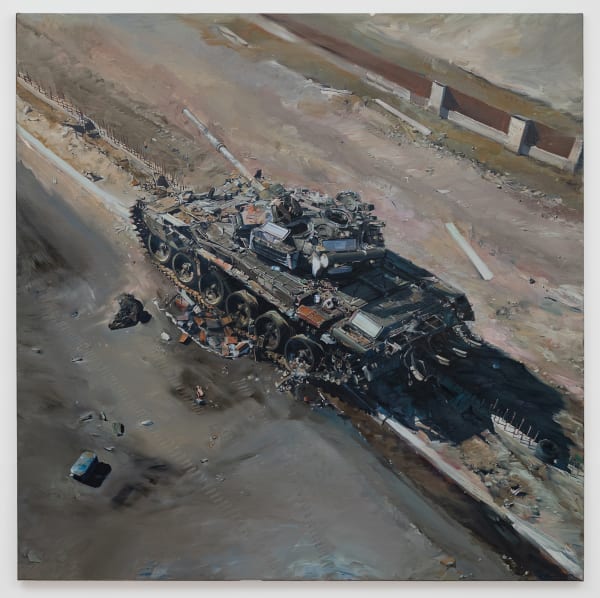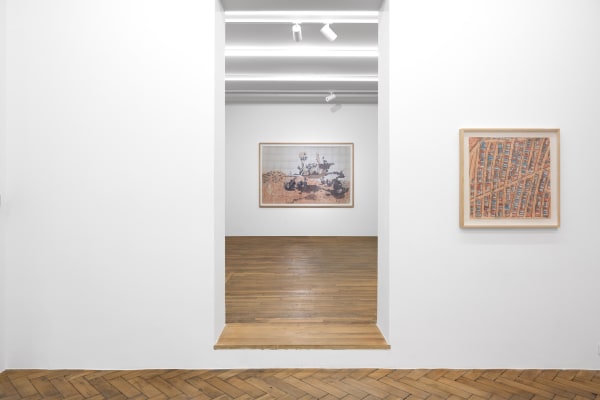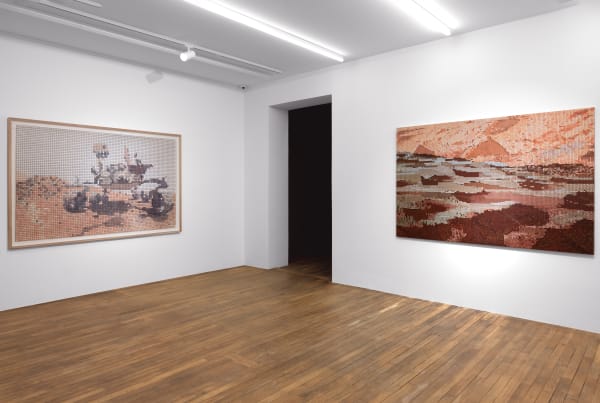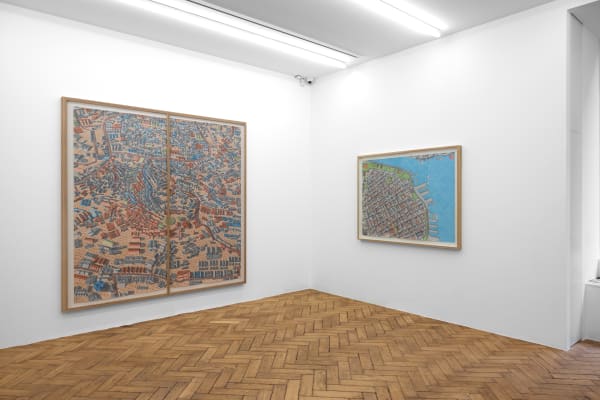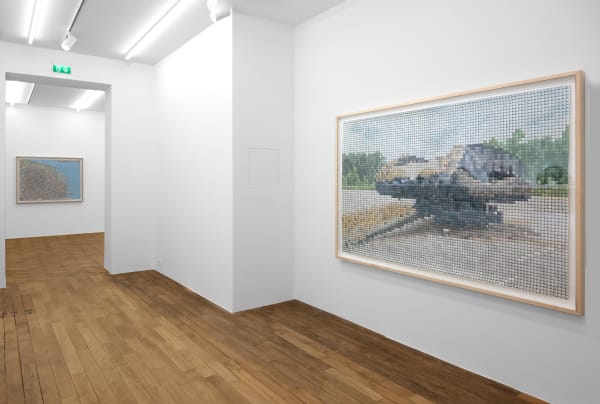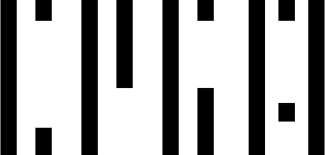Dagoberto Rodríguez: Solar StormGalerie Peter Kilchmann, Paris
Galerie Peter Kilchmann is delighted to present its second solo exhibition; and the first in France; by Cuban artist Dagoberto Rodríguez (b. 1969 in Havana; lives and works in Madrid) at our new Paris gallery.
Visitors are welcomed by a helmet in the window, which belongs to a set of 7 other identical helmets (NIDEC CSC10, variable dimensions) presented on a shelf in one of the gallery spaces. These helmets, accessories of warrior cultures, are also associated with police forces. Cast here in sparkling aluminium, aligned in an almost rigid order, they contrast strangely with the anarchic and chaotic conglomerate of objects spilling over onto a Russian tank, which rolls over them (Tanque ruso, 150 x 150 cm). In a simultaneously hyper-realistic and almost abstract way, Rodríguez engages in a stylistic exercise, alternating between muted colours and bright touches; smooth glosses and thicknesses. Another tank, on paper this time (Tanque Ruso IV, 130 x 200 cm), drawn according to a Lego motif, is reminiscent of planet-exploring robots. We get the feeling these machine-vehicles are also tools of colonisation and/or weapons of destruction.
One of the deadly consequences of war, of course, is the spread of refugee camps. Rodríguez focuses here on several recent tragedies. Most refugees travelling from Africa in an attempt to reach Europe arrive at the Moria camp on the island of Lesbos in Greece (Moria Refugee Camp, 100 x 130 cm). In Havana, the locals who meet in the old city of the port, hoping to leave the island to flee the political, social and economic crisis that has beset Cuba, feel just as imprisoned, although it is not strictly a refugee camp (Havana Refugee Camp I, 100 x 130 cm). In Bangladesh, since 2017, hundreds of thousands of Rohingya refugees, mostly Muslims, have been fleeing a Burmese army offensive and now crowd together in dire sanitary conditions (Rohinyia Refugee Camp, 200 x 200 cm). The aesthetic and almost playful dimension of the wide shots seen from the sky engages the viewer in paradoxical ways. The Lego motif keeps the subject at a distance on the one hand, and subtracts the viewer from an immediate understanding of the object on the other. He is therefore torn between several perspectives on actions: playing, reorganising, demolishing, building… The possibility of a reversal of meaning emerges at the same time as the reversal of the image.
In addition, three landscapes of dunes spread out in a palette of earthy tones and clay-like colours. Mechanical elements disrupt the apparent calm of these sandy, rocky expanses. The grey dunes of Bagnold (Bagnold Dune, 135 x 200 cm) are surveyed by a NASA geology robot in search of traces of water. Further on, a similar machine inspects the Jezero crater on the planet Mars (Jezero Crater, 135 x 200 cm). In 2021, the Perseverance rover confirmed that this crater was home to a lake some 3.6 billion years ago (Perseverance, 130 x 200 cm). Human beings, with constancy, watch for any trace of potential past lives, a presage of those they could invest in these extra-terrestrial spaces. These paintings, on canvas and on paper, borrow their iconography from Lego, one of the artist’s favorite motifs, which simultaneously represents the mediatisation, digitalisation, technologization, and pixelation of our universe. Realities are altered, fictions fragmented, echoing the multiple layers of languages and the plural interpretations of images. These plastic bricks also carry within them the possibility of collapse, of decadence. Incidentally, the planet Mars takes its name from the god of the Roman pantheon. The disturbances we cause in our fantasies of prosperity in all these territories suggest that any community driven by a desire for colonisation would ultimately be an embodiment of the tutelary figure of the warlord.
In the final room, a digital animation is projected (Tormento Solar, 2:06 min.). This futuristic vision manages to poetically resolve these patterns of conquest. In this space mythology, a movement brings us ever closer to the explosion of a heat source which pulsates like a heart. The artificial bricks crackle. Is the sun defending itself from such solicitation? Are we burning our wings, drawn in spite of ourselves to the light it emits? Naturally, Rodríguez is addressing the impact of technologies on the environment and on humanity, but his purpose is not so much to denounce these things as to offer a romantic mirror with which to confront the reflection of the structures of our impulses. These inherited forms of conditioning drive us and make our modern destinies contagious.
-
 Dagoberto Rodriguez, Bagnold Dune, 2023
Dagoberto Rodriguez, Bagnold Dune, 2023 -
 Dagoberto Rodriguez, Jezero Crater, 2023
Dagoberto Rodriguez, Jezero Crater, 2023 -
 Dagoberto Rodriguez, NIDEC CSC10, 2023
Dagoberto Rodriguez, NIDEC CSC10, 2023 -
 Dagoberto Rodriguez, Solar Storm, 2022
Dagoberto Rodriguez, Solar Storm, 2022 -
 Dagoberto Rodriguez, Tanque Ruso, 2022
Dagoberto Rodriguez, Tanque Ruso, 2022 -
 Dagoberto Rodriguez, Tanque Ruso IV, 2022
Dagoberto Rodriguez, Tanque Ruso IV, 2022 -
 Dagoberto Rodriguez, Zaatari Refugee Camp, 2023
Dagoberto Rodriguez, Zaatari Refugee Camp, 2023 -
 Dagoberto Rodriguez, Rohingya Refugee Camp, 2023
Dagoberto Rodriguez, Rohingya Refugee Camp, 2023 -
 Dagoberto Rodriguez, Moria Refugee Camp, 2023
Dagoberto Rodriguez, Moria Refugee Camp, 2023





